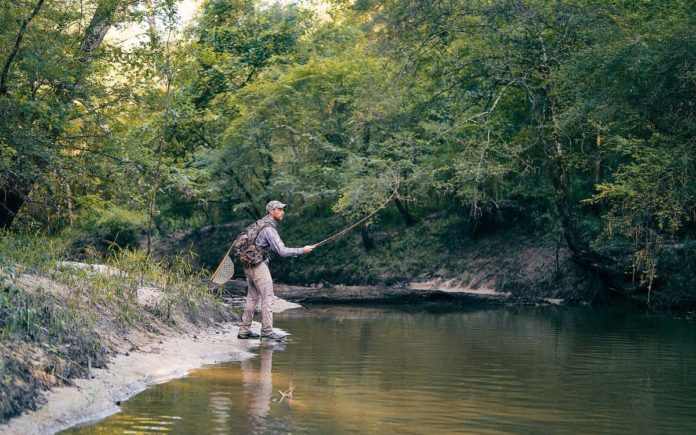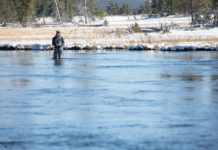When you think of fly-fishing in Texas, what comes to mind? Perhaps it’s a hand-tied streamer teasing a Guadalupe bass in a clear, swift Hill Country stream. Or maybe it’s sight-casting toward the flash of a redfish tail on a tidal flat along the coast. Or perhaps it’s the memory of an adventure on the remote and rugged Devils River in pursuit of hard-fighting smallmouth bass. You probably don’t picture the tree-choked creeks and bayous in muddy East Texas. This rainy, woodsy part of the state is best known to anglers for the monster gar, catfish, and bass lurking in vast man-made reservoirs. But one Houstonian is hoping to change the region’s reputation.
Rob McConnell, an oil-field geologist by day, is the author of Fly Fishing the Sam: A Guidebook to Exploring the Creeks, Rivers, and Bayous of the Sam Houston National Forest. After moving to Houston from the Appalachian region of Pennsylvania six years ago, he’s become something of a fly-fishing evangelist for Piney Woods waterways.
Shortly before daybreak one morning this spring, I met McConnell, a soft-spoken man of 33, at his house in Houston and followed him to a remote spot in the Sam Houston National Forest about midway between the towns of Cleveland and Coldspring. Walking through the woods with our gear, we located the Lone Star Hiking Trail and followed it for half a mile until we reached a wooden footbridge above the East Fork of the San Jacinto River, one of McConnell’s favorite waterways. “There’s a lot of scrambling because the banks are so steep,” McConnell warned as we left the bridge and walked the bank upstream. “I hope you’re all right with getting muddy.”
Two years ago, when McConnell first conceived of his book, he worried that readers wouldn’t bite on the notion of East Texas fly-fishing, especially since it doesn’t involve a picturesque vacation in the Hill Country or the Mountain West. But his timing turned out to be excellent. Fly Fishing the Sam was self-published in March 2020, just as the COVID-19 pandemic was sweeping the United States. Suddenly, having fun closer to home had gained broader appeal. “I can’t go to Colorado this year,” McConnell imagined potential readers saying. “Guess I’ll fish that swamp in the Sam Houston National Forest.”

Small East Texas streams may not get much attention, but they’re worth exploring for their wide variety of panfish such as bluegill, warmouth, and longear sunfish, a beautifully bright species with a vibrant orange belly that contrasts with turquoise markings on its sides. There are also crappie and channel catfish and a few species of bass, most notably the spotted bass, a predator that lurks in medium-swift currents. “Spotted bass are super aggressive,” McConnell said. “You find them in riffles, and they fight like trout.”
The East Fork, which looks more like a small creek than an actual river, has the right conditions for a healthy population of spotted bass. There was a gentle current, and the water was much clearer than I expected, although the abundant pools were deeper and murkier. We were fishing with lightweight gear—three- and four-weight rods—and subsurface flies that McConnell nicknamed “San Jac Squirrels” because he ties them from the fur of squirrels he hunts in the national forest. Each fly takes fifteen minutes to tie. “I make them overly complicated. I just like incorporating the natural material from these woods,” he said, gesturing at the forest. McConnell always starts with San Jac Squirrels. If the fish aren’t biting, he swaps in other flies that imitate natural forage—such as dragonfly nymphs or small baitfish.
Maneuvering between the relatively steep banks while dodging the occasional overhanging limb, we rarely had room for long overhead casts, but we easily made shorter roll casts, snapping the line into fishy-looking spots. After letting the fly sink for a second or two, we’d walk it downstream, the San Jac Squirrel bouncing along the bottom like a damselfly larva. We’d cast a few times in one hole and then hit the next, splashing our way down a creek bed that wasn’t nearly as muddy as I expected.

As for the water itself, that was another surprise: it felt great. “The water stays cool all year,” McConnell said. “When it’s a hundred degrees out and people have a hard time fishing the coast, they can come up here in the shade and be completely comfortable.”
Over the past several years, McConnell has yet to encounter another angler on the East Fork of the San Jacinto or its tributary, Winters Bayou, his other go-to spot in Sam Houston. But fly-fishing in East Texas seems to be gaining a small following, said Alice Best, a Texas Parks and Wildlife Department biologist who supervises inland fisheries in the Houston area. Part of the appeal is the abundance of fishing spots. “Pretty much any ditch or stream has decent fly-fishing,” Best said.
For anglers who want to stick even closer to Houston than Sam Houston National Forest, Best says “there are surprisingly nice stretches of stream in the center of Houston,” including Buffalo Bayou Park, near the heart of the city. Her favorite spot in town, though, is along Spring Creek, on the city’s northeastern side. “It feels like you’re out in the middle of nowhere, but you’re twenty minutes from George Bush Intercontinental Airport.”
A year and a half after publishing Fly Fishing the Sam, McConnell is working on a second book that will serve as a guide to the waterways of Houston and surrounding areas, where anglers can have just as much fun targeting invasive tilapia and grass carp in concrete-lined drainage ditches as they do exploring the more scenic reaches of Buffalo Bayou. McConnell doesn’t deny the joys of using conventional tackle to haul in lunker bass from East Texas lakes, a far more popular pursuit in the region. But the small streams of the Piney Woods remain his first love. “It’s definitely not for everybody,” he said. “You’re completely surrounded by nature. You’re not gonna see anybody all day. The fish are aggressive and they’re small, but they’re beautiful. They’re native. They’re supposed to be here. They’re not something we drug in and dumped in a lake. These fish have been here since there was an East Fork of the San Jacinto.”

McConnell landing his catch.
Photograph by Nick Simonite

McConnell holding a spotted bass, an aggressive Texas native species that lurks in medium-swift currents.
Photograph by Wes Ferguson
McConnell has a few recommendations for anglers who want to explore these streams for themselves. First, don’t wear sandals. Opt for closed-toe shoes that can get muddy and will protect your feet from submerged tree branches. Second, keep your bearings in the forest by sticking to the river, where the only directions that matter are upstream and downstream. Third, release the fish you catch. “Once you become a fly angler, you don’t need to eat the fish,” he said. “That’s one thing I get a little worried about, is if people start coming up here and treble-hooking everything in the face and dragging it out. What’s the point? You’d basically get one bite out of a longear sunfish.”
In a few hours of wandering up and down the East Fork, McConnell and I enjoyed almost nonstop action, with bluegills attacking the San Jac Squirrels in nearly every hole we encountered. Here and there, mature oaks bent over the water, their trunks covered in moss. Beyond the banks, palmettos offered splashes of vibrant green in the forest shade. The scenery didn’t exactly scream “destination vacation,” but it was still lovely and gave McConnell a sense of hometown pride. “This is our wilderness,” he said. “This is Houstonians’ wilderness.”
As McConnell talked, I felt a twitch on the end of my line, so I jerked the rod and set the hook. I had something. The fish tried to dart away. It was surprisingly feisty, pulling and fighting as I began to reel. Suddenly, it leaped, a shiny little thing twirling in the sunlight. “You got a fish, dude!” McConnell said. “Oh, it’s a spotted bass!”
He netted my catch, the first spotted bass of the day for me. We knelt for a better look. “Wow,” McConnell said. “Look at his paunch. He’s been eating!” A brook trout this size—about seven inches—from a blue-ribbon Appalachian stream would come with major bragging rights, McConnell pointed out. Although most anglers might be unimpressed by the native fish that swim in Piney Woods creeks, he believes they’re no less special. “They’re just as tenacious. They’re just as fun,” he said. “In the heat of summer when bugs are flying around, you can catch them on topwater. If you fish in a brook trout stream, it’s a monoculture. You go there, you catch brook trout, and that’s all you’re gonna catch all day.”
We released my catch back into the stream and trudged our way back to the car. The forest was lush and quiet in the late-morning heat, a world removed from the sprawling metropolis just to our south. We enjoyed tight lines all morning, and McConnell was back home, in Houston, by lunchtime.
This article originally appeared in the August 2021 issue of Texas Monthly with the headline “East Texas on the Fly.” Subscribe today.
Credit: Source link































